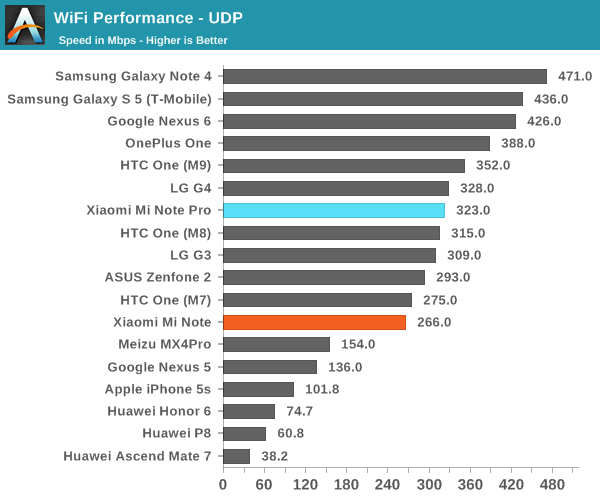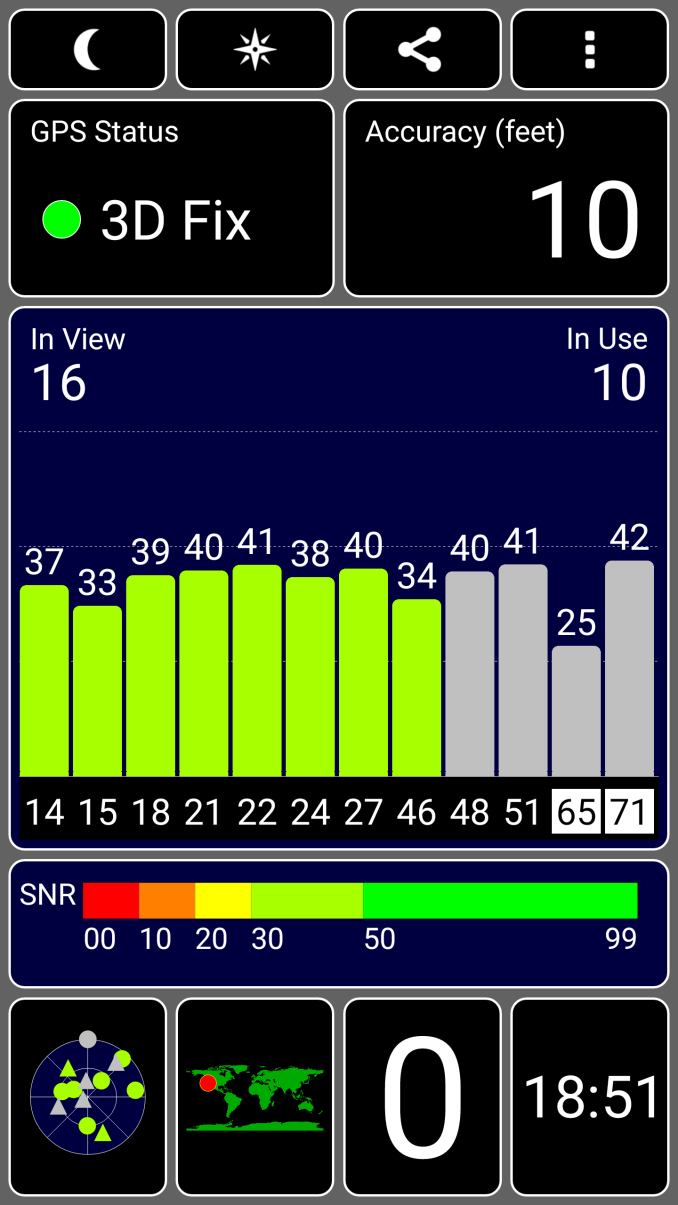The Xiaomi Mi Note Pro and Mi Note Review
by Joshua Ho on September 11, 2015 9:00 AM ESTWiFi Performance
Even though smartphones are usually considered to be necessary for their mobile data capabilities, smartphones and tablets tend to spend a lot of time on WiFi networks instead. As a result, it’s important to have a smartphone with good WiFi connectivity as otherwise there’s potential for poor bandwidth, connection reliability, and frequent drop-outs from a router. Anyone that has tried a smartphone with poor WiFi will probably understand just how frustrating all of these things can be. In order to try and approach testing a complex radio subsystem, we’ve settled for a relatively simple bandwidth test using iPerf to see what the maximum UDP download rate is on the device under test. In the case of the Xiaomi Mi Note, we see a Qualcomm Atheros WCN3680 WiFi chipset, and the Mi Note Pro appears to use a QCA6174 despite only enabling a single spatial stream.

Interestingly, the Mi Note Pro ends up with a higher peak bandwidth result than the Mi Note even though both are using a single spatial stream. I’m not sure what’s causing this, as performance between the two should be relatively as the main performance improvement from QCA6174 should be dual spatial stream 802.11ac. Either way, neither should have significant problems in everyday use of WiFi given dual band support and support for the latest standards.
GNSS
Location services are surprisingly important in a smartphone. Without highly accurate, reliable, and fast location fixes a number of applications in a smartphone would be difficult if not impossible to implement. Turn by turn navigation is easily one of the most common and critical location-based applications a phone will run, and poor GNSS performance is a good way to make sure it never gets used. In order to test this, we run a standard GPS information application and attempt to accurately track just how fast it takes for a phone to acquire a lock without any GPS assistance (airplane mode) and no pre-existing assistance data. In the case of the Xiaomi Mi Note phones, the GNSS solution is likely to be integrated into Qualcomm’s modem, which means that with any kind of mobile data connection time to first lock is on the order of 5 seconds.
Running the test previously described, the Mi Note line appears to achieve first lock in roughly 40 seconds, and almost immediately after first lock is acquired accuracy is at 10 feet. It’s actually quite rare for a phone to achieve this, as most phones usually take at least an extra 10-30 seconds to get down to usable accuracy levels once first lock is achieved. Received signal strength is quite strong with most satellites strongly in the 30 dB SNR range.
Misc
While we don't really have the necessary equipment to do audio right, I noticed a number of things on the Mi Note series that seems to set the Mi Note line apart from other phones I've tested recently in audio performance. The first thing worth noting is that the speaker gets painfully loud, to the point where I usually keep volume under half of the maximum. I normally keep something like the One M8 closer to 75-100% volume, so it's pretty safe to say that these phones can pretty much reach unsafe levels of volume if you want them to. There's also a Saber ES9018 DAC connected to the phone over i2c which is probably used for 3.5mm output, and the speaker's amplifier is driven by Texas Instruments' TAS2552 which can reach a maximum of 4 watts. The touch screen on both appears to be Synaptics' in-cell touch solution if you go by system files, but for some reason the ITO grid is still visible.











94 Comments
View All Comments
Mike89 - Thursday, October 15, 2015 - link
Xiaomi phones are not optimized for the US. I bought the Redmi Note 2 and when I got it found it would only do 2G in the US no matter the carrier. For every model number there are numerous sub versions of the same model number for different Countries and for the most part the vendors don't tell you which one they are selling. Mine (from Gearbest) was the China version even though it was stated "worldwide". Doesn't have the right bands or the right bands activated for US use.1010101100 - Thursday, October 29, 2015 - link
Did you even research the product you wanted before getting it? Did take time to check what bands were supported for the product? Did you have knowledge that not all out of state phones might not work within the US? Lastly did you research to see what data speed your carrier provided for the product you were planning to buy? I'm using a Mi Note Pro right now and have no complaints about my data speed since I know for sure at best right now its HSPA+ on T-Mobile or ATT, currently on the GoSmart mobile prepaid network available in NYC. Like someone mentioned earlier majority of our products sold in the US is produced from China for cheap labor and production cost. The design of a certain product can be from US but was not produced in US but from another country mainly China hence the term "Made in China". Leather goods from India or Italy. Surely US is not at a point where it's just stealing credit for the manual labor? I mean Apple has already been stealing credit for where it should be given.irresistible - Thursday, July 7, 2016 - link
After reading this review I decieded to buy an Xiaomi Note Pro for 500€ including all shipping costs and taxes.Today I own an Xiaomi Note Pro for over seven months now and while using it daily, I can assure you the following :
1. Qualcomm Snapdragon 810 has different versions (check here http://www.anandtech.com/show/9388/comparing-snapd...
Xiaomi Note Pro has one of the best version (v.2.1), if not the best version. Therefore the main overheating issue does not exist. From my real-world testing, I assure you that it's not getting warm at 30 degree Celsius room temperature when doing basic tasks (messaging, calls, browsing and so on). When playing taxing games, it will get warm (not hot!) at 30 degree Celsius room temperature. When watching movies for many hours with hardware-acceleration (mandatory in my opinion) your phone will get warm (not hot!). So basically if your room-temperature is about 20 degree Celsius your phone will not even get warm. Were is the overheating issue? If you are gaming 24/7h on max brightness without hardware-acceleration, you might experience throttling. All other scenarios have 0 overheating issues. In my opinion Xiaomi Note Pro is not optimal for heavy daily gaming.
2. Camera
It's okay for most people, but nothing special. Shooting is very quick. Like SNAP (1sec) and picture is taken :). It's true that the low-light performance is not good, but which phone has good low-light performance? Oh, yea you are right, flaghship phones which STARTS at 500-700$.
3. Storage
Non-expandable storage is not always to be seen negatively. Xiaomi Note Pro is 6.9mm thick and it was released at a date were micro-SD slot was not implemented on flagship phones for various reasons. And still to-date there is only a handful phones e.g. Samsung Galaxy S7 which incorporate flagship design with an micro-SD card slot. For the vast majority of users 64GB is more than enough. And those who want more, shouldn't buy this phone.
4. Battery Life
You cannot call battery life: subpar. Why not? This phone is only 6.9mm thick (!!!) and comes with an 1440p display (!!!). And they were able to implement an 3000mah battery, which is huge. But it's also true that it's powerdraw ratio is not that good. Battery lasts about one whole day for most tasks including watching videos (hardware accelerated). You can drastically optimize your battery life with xposed modules e.g. amplifiy, greenify and so on. If you want even more battery life, you can buy Xiaomi Note (non-pro) edition. If you want to do heavy gaming over multiple hours, you shouldn't buy this phone. Games, especially not hardware-accelerated on max brightness will drain your battery fairly quickly. If the battery capacity would be about 2000mah, I would call that sub-par, not 3000mah. Do not forget that this phone is supporting Quick Charge 2.0, your charging time is not that long compared to other phones.
5. Gaming in general
If you are like me and play games on your phone occasionally on the way to work or school or whatever, your battery life will be fine. But if you are sitting down on breaks or e.g. in a park with super nice sunlight playing 3-5 hours at max. brightness your favorite JRPG, your battery won't last a whole day. If you are me, you would solve this issue by connecting an sleek powerbank from Xiaomi :)
If you have any questions, feel freeeeeeeeeeeeeeeeeeeeee to ask meeeeeeeeeee.
I would like to end this write-up with the following:
Xiaomi Mi Note Pro is the best 1440p 5.7" smartphone in the world. Only Galaxy Note 5 can compete. (summer 2016)
Coffeemilotea - Saturday, October 8, 2016 - link
Hi is your phone with Android 6.0 Marshmallow or KitKat with MIUI 8? Thanks.